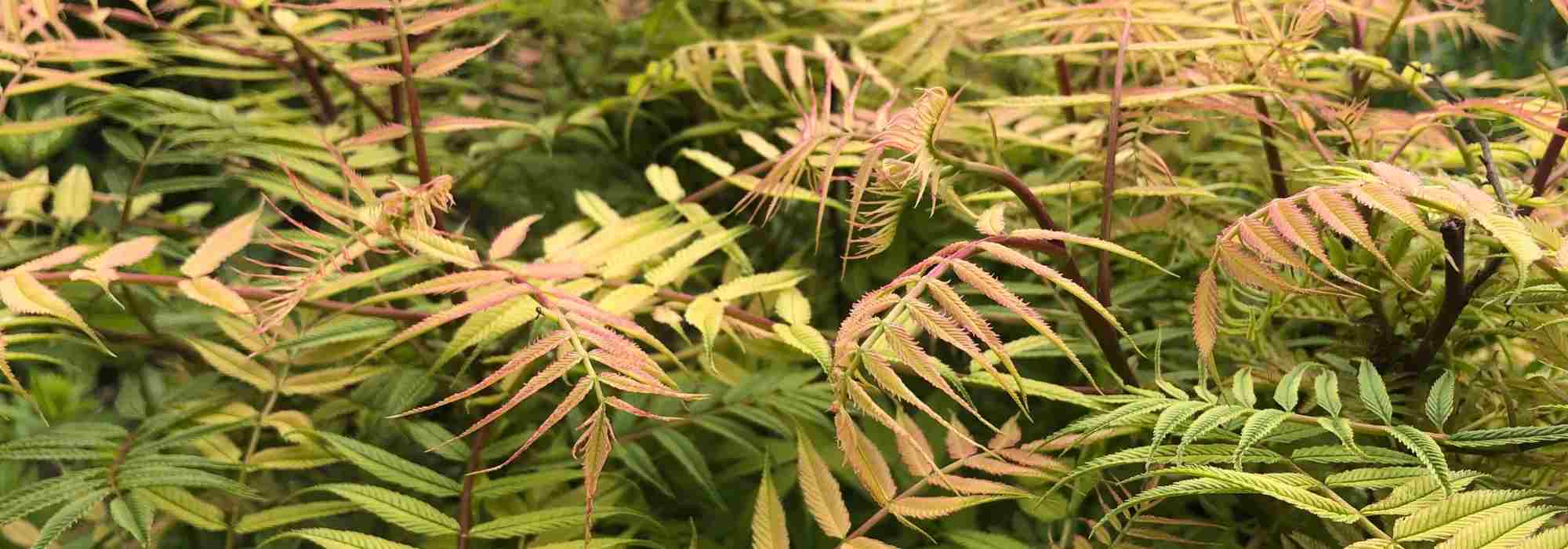
Sorbaria sorbifolia, false spiraea: planting, growing
Contents
Sorbaria sorbifolia in a nutshell
- It is a beautiful bush with vigorous summer flowering that is low-maintenance
- Its elegant fern-like foliage is spectacular from spring to autumn
- It offers white flowering in graceful white panicles
- Extremely hardy, it thrives in any good garden soil that remains cool, even moist
- It can be placed in a large shrub border, in a free-standing hedge, or near a water feature
A word from our expert
Vigorous, very hardy, and fast-growing, Sorbaria sorbifolia, also known as “false spiraea with rowan-like leaves” is a low-maintenance bush, ideal for lazy gardeners, particularly easy to succeed in any cool soil. It is remarkable for its light, white summer flowering and its delicate, finely cut deciduous foliage. While the species type boasts a beautiful vigour, a suckering nature, and a somewhat unruly appearance, its cultivars such as Sorbaria sorbifolia ‘Sem’ and ‘Pink Hopi’ have a more modest size, a less invasive character, and splendid spring foliage tinged with pink.
Planted in a sunny position, in any good garden soil that remains cool, it quickly forms beautiful masses of foliage that are easy to prune.
Rarely exceeding 1.60 m in height, up to 2 m for the wild species, it will particularly thrive near natural ponds or water features, among large bushes or robust perennials, or even in large pots placed on a terrace or balcony.
Discover this elegant bush with the appearance of a large, colourful fern!
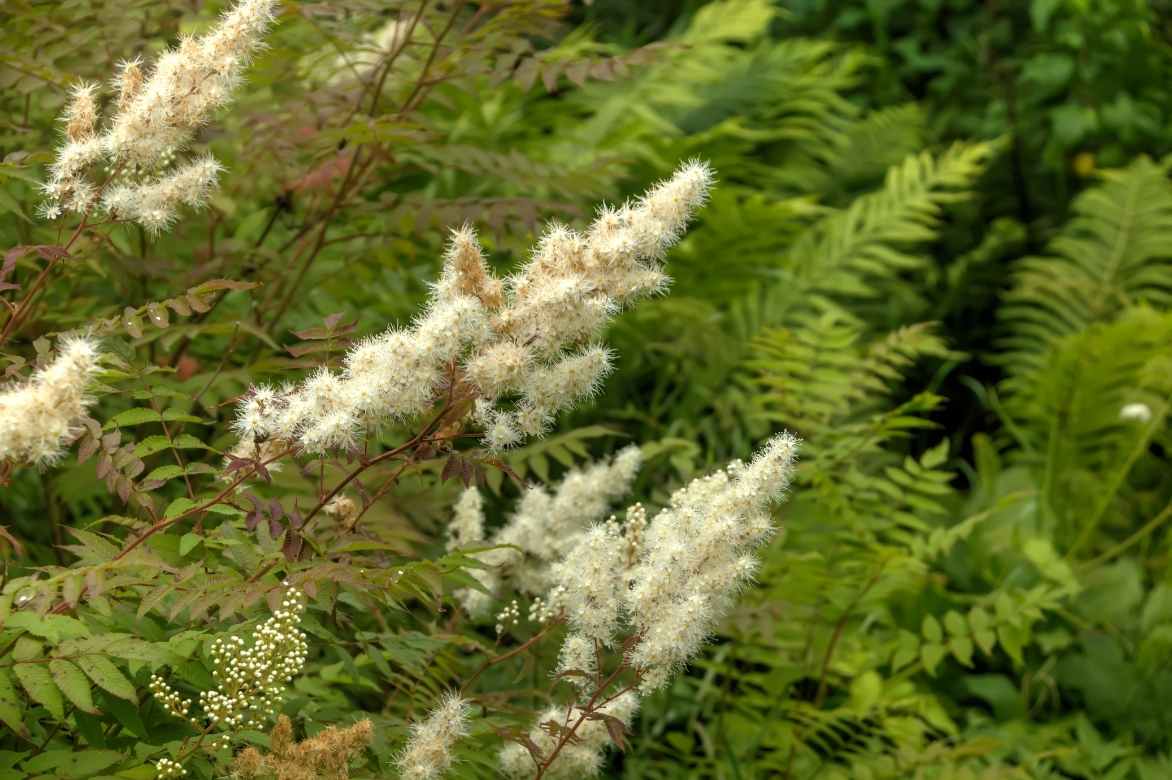
Sorbaria sorbifolia: a magnificent plant resembling a fern
Description and botany
Botanical data
- Latin name Sorbaria sorbifolia
- Family Rosaceae
- Common name False spiraea, Sorbaria with rowan-like leaves
- Flowering June to August
- Height 1.5 to 2m
- Exposure Sun, partial shade
- Soil type All, fresh to moist, well-drained
- Hardiness -20 °C and below
Sorbaria sorbifolia, also known as “false spiraea with rowan-like leaves”, is a deciduous bush belonging to the Rosaceae family. Originating from Siberia (the Ural) and East Asia (China, Korea, Mongolia, Japan), it has retained a high level of hardiness, down to -20°C. It primarily grows at the edges of forests and undergrowth, in fresh soil, where it naturally forms dense hedges.
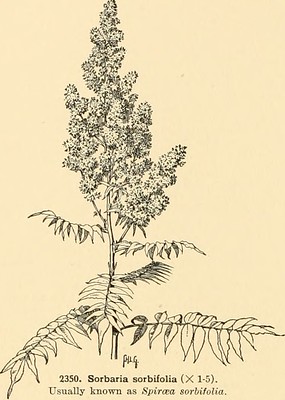
Sorbaria sorbifolia – botanical illustration 1906
The genus comprises about 10 species, including Sorbaria sorbifolia, which has given rise to horticultural varieties such as Sorbaria sorbifolia ‘Sem’, which are smaller and more compact, even more cold-tolerant and less suckering than the typical species.
The false spiraea with rowan-like leaves quickly forms a small dense bush with a spreading and arching habit. While the typical species can grow up to 2.5 m tall, its cultivars show a more moderate growth, sometimes not exceeding 1.6 m in height for 1 m in width, with a less unruly, more compact and upright habit.
This shrub is very prone to suckering, meaning it produces numerous shoots around the stump. In fresh soil, if it thrives, it can become invasive. The wild species tends to naturalise over the years, forming large impenetrable thickets, a boon if you wish to vegetate a wild corner of the garden.
In spring, the branches are adorned with beautiful deciduous foliage that varies significantly among cultivars. The Sorbaria sorbifolia is valued for its pinnate, finely dissected foliage, which is both light and spectacular. It is beautifully layered, with rare elegance, evoking the lightness of fern fronds. This foliage consists of 11 to 25 lanceolate and dentate leaflets, measuring 5 to 20 cm long. The leaves are deciduous, alternate, and odd-pinnate (they have an odd number of leaflets). They emerge in spring on the numerous upright branches, which are green in the typical species and bright brown to red in the cultivars.
Coppery pink in spring, then fresh green, to glossy green in summer in Sorbaria sorbifolia, their colour evolves through the seasons, turning yellow in autumn before falling. The Sorbaria sorbifolia ‘Pink Hopi’ and Sorbaria sorbifolia ‘Sem’ stand out for their splendid purple-pink hues from spring to summer against a backdrop of chartreuse green that reddens again in autumn.
In summer, an abundant white and feathery flowering covers the foliage like a cloud. It appears on this ample and attractive foliage from spring to autumn. Like the spiraeas, it is one of the few shrubs that bloom in mid-summer. The flowering occurs in July-August in the form of opulent yet light, terminal and pyramidal panicles up to 25 cm long. They consist of small creamy-white flowers with 5 petals. These flowers, resembling those of apple trees, dot the foliage for many weeks. They release long and numerous stamens, giving a fluffy appearance to these inflorescences and a giant astilbe look to the entire plant. They are heavily visited during summer by pollinators, butterflies, bees, and bumblebees.
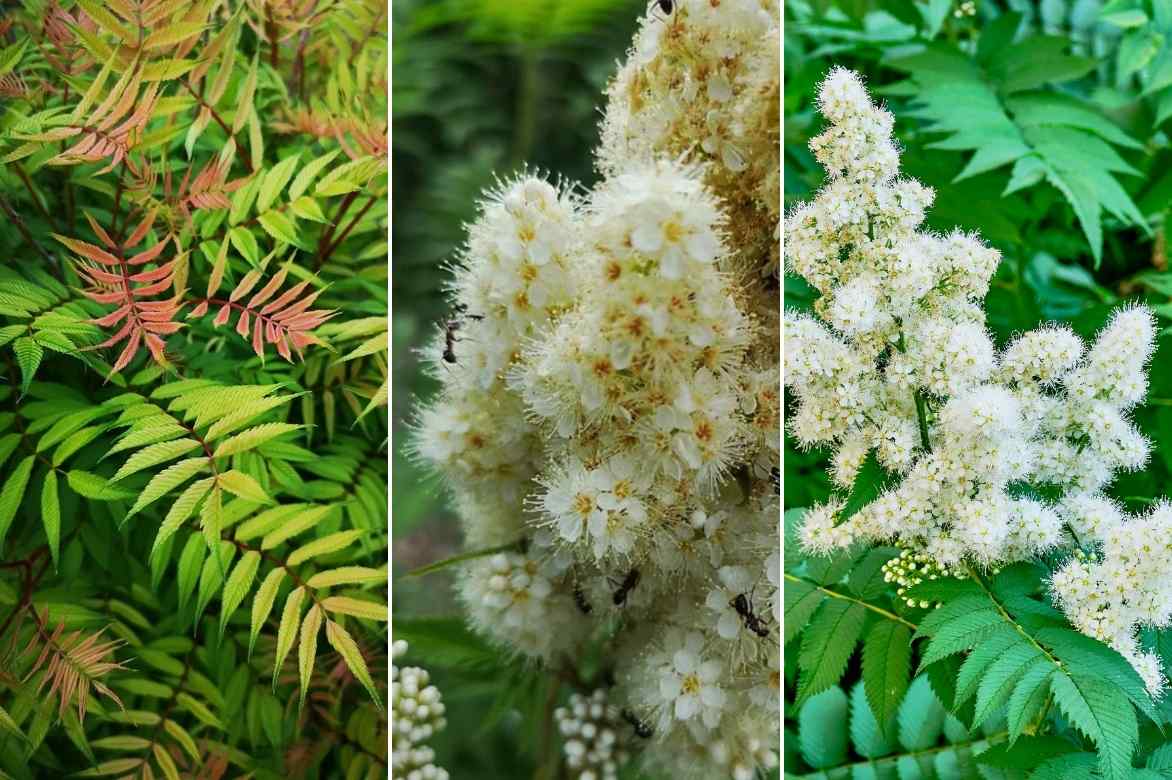
Foliage and flowering of Sorbaria sorbifolia ‘Sem’, on the right, greener foliage and feathery flowers of Sorbaria sorbifolia
Main species and varieties
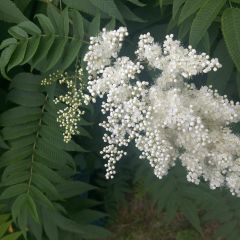
Sorbaria sorbifolia
- Période de floraison July to September
- Hauteur à maturité 2 m
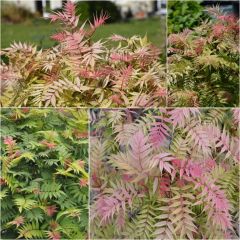
Sorbaria sorbifolia Pink Hopi
- Période de floraison August, September
- Hauteur à maturité 1,60 m
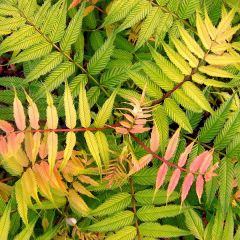
Sorbaria sorbifolia Sem
- Période de floraison August, September
- Hauteur à maturité 1,50 m
Planting the false spiraea with rowan-like leaves
Where to plant?
Very hardy down to -20, sometimes -30°C, the Sorbaria sorbifolia originates from areas with a very harsh climate. It grows well in all our regions, except perhaps in Mediterranean climates as it fears conditions that are too arid, too dry, and hot in summer. It is particularly suited to moist soils. Dry or stony soils are not suitable for it at all.
This bush prefers full sun, which enhances the colours of its leaves and promotes better flowering, although it can tolerate partial shade. Provide it with a well-exposed location as it enjoys cool but bright environments. Easy to cultivate, it appreciates any good drained garden soil that remains cool, even moist. It can tolerate slightly calcareous or slightly acidic soil.
A cool, rich soil allows it to develop vigorously: near water points or in damp soil, it can colonise a fairly large area.
This bush is perfect at the back of a border, in a free hedge, or to hide an unsightly wall. It also adds a lot of relief and lightness to all natural and wild gardens and near water features or in the marshy areas of the garden. Its suckering nature and rapid growth help stabilise slopes.
Small cultivars will find their place among larger bushes, in cool or damp flowerbeds. They will also be welcome in small gardens and city gardens or in large pots on a terrace or balcony.
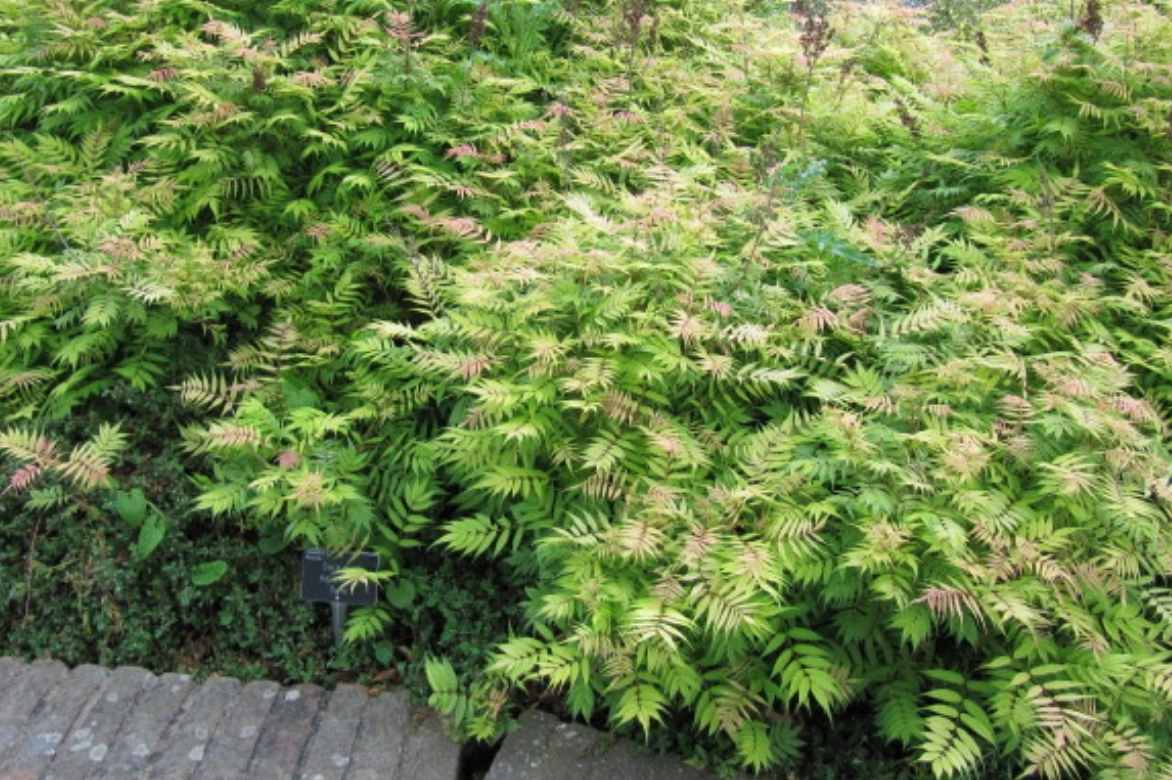
Sorbaria sorbifolia ‘Sem’ (© Leonora Enking)
When to plant?
Planting the false spiraea with sorb leaf should be preferably done in spring, when temperatures have warmed and frosts have ended. Planting in early autumn is possible, provided the young plant is protected from the rigours of the first winter.
How to plant?
In the ground
Allow sufficient spacing as the Sorbaria sorbifolia fills out quite quickly. Plant one specimen so that the plant can develop well.
- Dig a hole 2 to 3 times the volume of the pot
- Add potting soil and compost to the extracted soil if it is not rich enough
- Plant so that the collar is above the soil
- Backfill and compact the soil well around the base
- Mulch to keep the base cool during summer
- Water generously at planting, then whenever the soil dries out at the base to ensure establishment
More tips for successfully planting a bush can be found on our sheet!
→ Also read: Invasive Sorbaria: how to limit its spread
In a pot
The substrate should be cool and draining. Choose small varieties like Sorbaria sorbifolia ‘Sem’. Provide a large pot of at least 60 cm in diameter and the same depth.
- Spread a good layer of drainage (gravel or clay balls) at the bottom of the container
- Plant the Sorbaria, with the collar level with the soil, in a mix of soil and potting soil for shrubs with a bit of compost
- Mulch the base
- Water abundantly without allowing the substrate to dry out between waterings
Read also
Pruning of summer-flowering bushesMaintenance, pruning, and potential diseases
False spiraea with rowan-like leaves is easy to grow as long as the soil remains cool and sufficiently nourishing.
In the first year after planting, monitor its water needs. Water every 15 days during the first two summers after planting to ensure good root establishment. It is essential to mulch around the base of young plants in summer to keep the soil moist and in winter to protect them from the cold. A good organic mulch around the base will limit evaporation during hot weather.
Each year, at the end of winter, consider adding compost or organic fertiliser at the base of the plant to support its growth and encourage flowering.
Watch for the appearance of suckers: remove them as soon as they appear with a garden fork to prevent spreading.
For false spiraea grown in pots, keep the root ball slightly moist at all times. To stimulate flowering, apply some organic fertiliser (well-rotted manure, horn meal, etc.) in spring and summer.
Repot every 2 to 3 years at the beginning of spring.
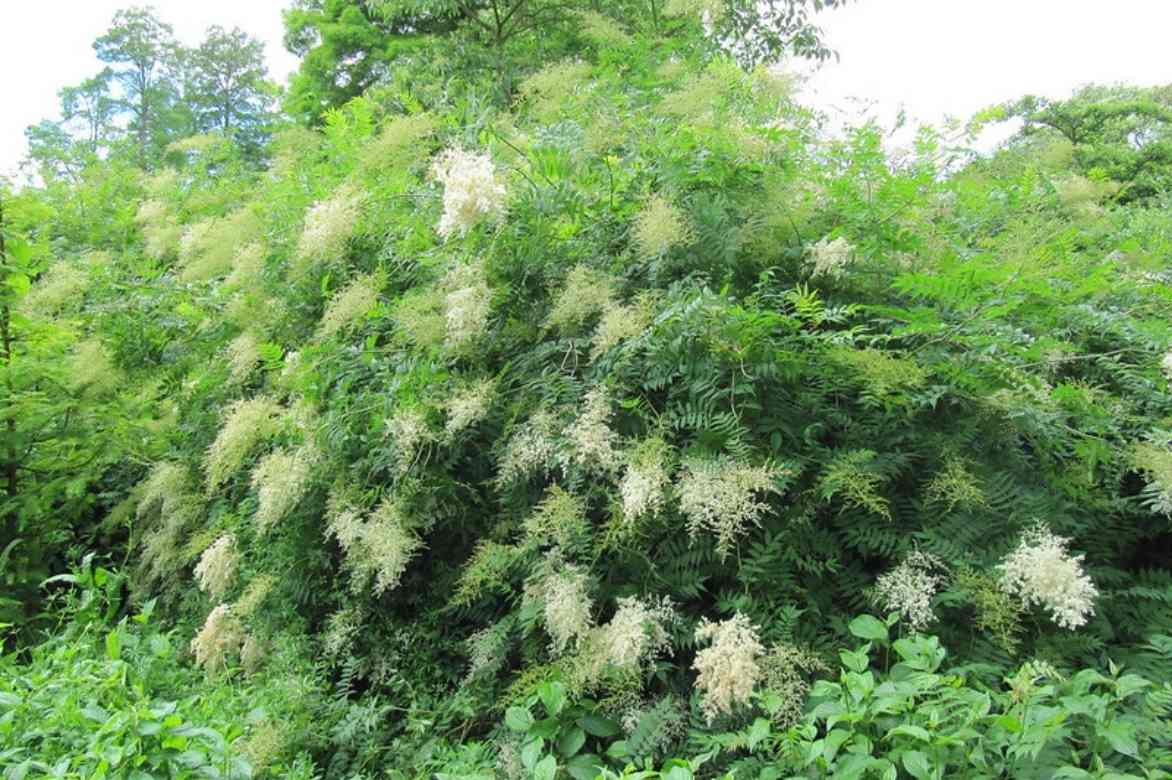
Sorbaria sorbifolia (© Leonora Enking)
Pruning
This bush flowers on the wood of the year and tolerates pruning well, even severely. Annual pruning helps maintain beautiful blooms and keeps a bushy, compact habit. A light annual refresh is sufficient, either at the end of summer or at the end of winter.
- During the season, prune with shears just at the base of 1 branch out of 4 to encourage the appearance of young shoots and colourful leaves.
- After flowering, prune the faded heads just above an eye.
- At the end of winter, prune all branches to 1/4 of their length.
- For an adult plant that is too bulky, a complete cutback is possible at the beginning of spring: cut the branches to about ten centimetres above the ground. Only perform this drastic pruning if necessary and occasionally, as it will deprive you of flowers the following year.
Also read: Pruning summer-flowering shrubs
Diseases
This bush is not affected by any serious diseases or pests.
Propagating
By sucker removal
Its tendency to produce suckers encourages propagation through the removal of shoots. At the very beginning of spring, take these rooted stems and replant them immediately in the chosen spot in well-aerated, fresh soil.
By cuttings
Additionally, false spiraea with rowan-like leaves can be easily propagated by semi-ripe cuttings.
- At the end of summer, take semi-woody shoots of 10 to 15 cm
- Make a 5 cm incision at the base of the bark
- Remove the leaves from the lower part of the stems
- Plant them in a well-draining mix of sand and potting soil
- Keep the substrate moist until rooting occurs
- Pot your cuttings into individual pots and keep them sheltered throughout the winter
- Transplant to the garden the following spring
By division
False spiraea with rowan-like leaves can also be propagated by dividing clumps. Work on a well-established plant.
- In autumn, using a fork, dig up part of the stump
- With a spade, slice off a good section
- Replant immediately in the garden in well-prepared soil
Pairing ideas
Sorbaria sorbifolia is a versatile bush ideal for brightening cool, sunny areas and infusing them with gradients of colour. It creates an elegant, colourful, and refined atmosphere. Following the spring flowering, it takes over with summer blooms.
With its light and fluffy silhouette, delicate and contrasting foliage, and poetic white flowering, it adds a touch of freshness to natural gardens, wild spaces, in a large romantic border, a damp flowerbed, or mixed in a flowering hedge.
It easily pairs with other summer-flowering shrubs in a border such as Buddleias (‘White Ball’), Cornus alba (‘Aurea’) with green-yellow foliage, or Acer negundo Flamingo – Ash-leaved Maple. It will flower a large bank with Japanese anemones.
By the edges of a pond, it pairs well with moist bank perennials, such as Gunnera manicata, Goat’s beard, rodgersias, meadowsweet, Astilbes, Polygonum, Typha laxmanii, and Eupatorium cannabinum.
In a colourful shrub border, its combination is perfect with a purple Berberis, Acer palmatum ‘Atropurpureum’, Viburnum opulus, Itea virginiana, Fothergilla major, and Salix purpurea nana.
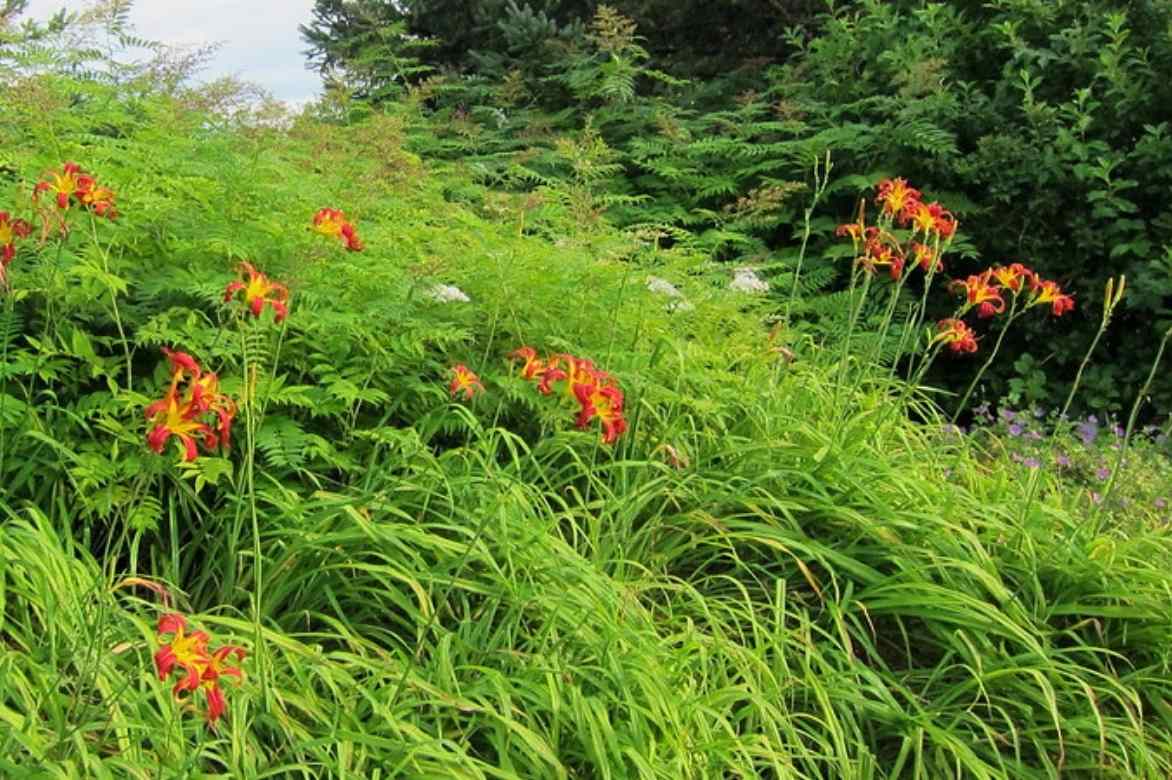
Association of Sorbaria sorbifolia, Hemerocallis ‘Red Ribbon’, and Geranium Rozanne (© Cultivar 413)
Useful resources
- Subscribe!
- Contents































Comments